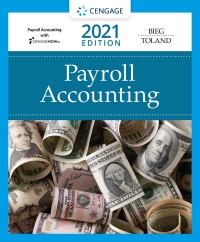Required Information Use the following information for the Exercises 3.7 below. (Algo) [The following information applies to the questions displayed below! Laker Company reported the following January purchases and sales data for its only product. The Company uses a perpetual Inventory System. For specific identification, ending inventory consists of 270 units from the January 30 purchase, 5 units from the January 20 purchase, and 15 units from beginning inventory Date Activities Units Acquired at Cost Units sold at Retail January 1 Beginning inventory 180 units S 10.50 $ 1,890 January 10 Sales 140 units $19.50 January 20 Purchase 110 units $ 9.50 1,045 January 23 Sales 138 units $ 19.50 January Purchase 270 units 5.9.00 2.630 Totals S60 units 5 5,365 270 units Exercise 5-3 (Algo) Perpetual: Inventory costing methods LO P1 Required: 1. Complete the table to determine the cost assigned to ending inventory and cost of goods sold using specific identification 2. Determine the cost assigned to ending inventory and to cost of goods sold using weighted average. 3. Determine the cost assigned to ending inventory and to cost of goods sold using FIFO. 4. Determine the cost assigned to ending inventory and to cost of goods sold using LIFO Complete this question by entering your answers in the tabs below. Specific Id Weighted Average FIFO UFO Complete the table to determine the cost assigned to ending inventory and cost of goods sold using specific identification, Available for Sale Specific. Identification Cost of Goods Sold Ending Inventory Purchase Date Activity of units Cast Per Unit of units Sold Cost Per Unit COGS Ending Inventory Units Cost Per Unit Ending Inventory. Cost January 1 January 20 January 30 Beginning inventory Purchase Purchase 180 110 270 500 0 0 0 $ Weighted Average > Use the following information for the Exercises 3-7 below. (Algo) The following information applies to the questions displayed below) Laker Company reported the following January purchases and sales data for its only product. The Company uses perpetual inventory system. For specific identification, ending inventory consists of 270 onts from the January 30 purchase, 5 units from the January 20 purchase, and 15 units from beginning inventory Acquired Cost 1 units 51. Se soldati tai 5 1, Date January 1 January 10 January 20 January 25 January 30 12 udts 5 10 15 Activities Beginning inventory Sales Purchase Sales Purchase Totals 11e units $ 9.5e 1.045 330 units $19.50 $9. 56 units 5 5,365 reunits Exercise 5-3 (Algo) Perpetual: Inventory costing methods LO P1 Required: 1. Complete the table to determine the cost assigned to ending inventory and cost of goods sold using specific identification 2 Determine the cost assigned to ending inventory and to cost of goods sold using weighted average 3. Determine the cost assigned to ending inventory and to cost of goods sold using RIFO 4. Determine the cost assigned to ending inventory and to cost of goods sold using LIFO ces Complete this question by entering your answers in the tabs below. Specific id Weighted Average FIFO LIFO Determine the cost assigned to ending inventory and to cost of goods sold using weighted average. Hound cost per unit to 2 decimal places Weighted Average-Pertual Cost of Goods Sold Goods Purchased Cost per of units unt Into Balance Date of units sold Cost per unit Cost of Goods Sold of units Cost per unit Inwestory Balance January 1 180 at 1050 1.800.00 January 10 January 20 Average cost January 20 January 25 January 20 Tatais Exercise 5-3 (Algo) Perpetual: Inventory costing methods LO P1 100 eBook Required: 1. Complete the table to determine the cost assigned to ending inventory and cost of goods sold using specific identification 2. Determine the cost assigned to ending inventory and to cost of goods sold using weighted average. 3. Determine the cost assigned to ending inventory and to cost of goods sold using FIFO. 4. Determine the cost assigned to ending inventory and to cost of goods sold using LIFO. Hint Complete this question by entering your answers in the tabs below. ACK Specific Id Weighted Average FIFO LIFO Print Determine the cost assigned to ending inventory and to cost of goods sold using FIFO. ferences Goods Purchased Perpetual FIFO Cost of Goods Sold #of units Cost Cost of Goods sold per unit Sold Date of units Cost per unit of units Inventory Balance Cost per unit Inventory Balance 5 10,50 $ 1,800.00 January 1801 January 10 January 20 Total January 20 January 25 Total January 25 January 30 Totals ( Weighted Average LIFO > 28 points Exercise 5-3 (Algo) Perpetual: Inventory costing methods LO P1 Required: eBook 1. Complete the table to determine the cost assigned to ending inventory and cost of goods sold using specific identification. 2. Determine the cost assigned to ending inventory and to cost of goods sold using weighted average 3. Determine the cost assigned to ending inventory and to cost of goods sold using FIFO. 4. Determine the cost assigned to ending Inventory and to cost of goods sold using LIFO. Hint Complete this question by entering your answers in the tabs below. Specific Id Weighted Average FIFO UFO Print Determine the cost assigned to ending inventory and to cost of goods sold using LIFO. References Goods Purchased of units Cost per unit Perpetual LIFO Cost of Goods Sold of units Cost Cost of Goods sold per unit Sold of units Inventory Balance Cost Inventory Balance per unit 5 10.50 $ 1.890.00 January 1 180 at January 10 1.045 at $ 1.045.00 1,045 January 20 1,045 at 1.045.00 1.092,025.00 Total January 20 $ 1.092.025.00 January 25 1.045.00 - $ 0.00 a Total January 25 January 30 Totals (FIFO










